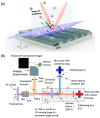Microscopies Enabled by Photonic Metamaterials
- PMID: 35161831
- PMCID: PMC8840465
- DOI: 10.3390/s22031086
Microscopies Enabled by Photonic Metamaterials
Abstract
In recent years, the biosensor research community has made rapid progress in the development of nanostructured materials capable of amplifying the interaction between light and biological matter. A common objective is to concentrate the electromagnetic energy associated with light into nanometer-scale volumes that, in many cases, can extend below the conventional Abbé diffraction limit. Dating back to the first application of surface plasmon resonance (SPR) for label-free detection of biomolecular interactions, resonant optical structures, including waveguides, ring resonators, and photonic crystals, have proven to be effective conduits for a wide range of optical enhancement effects that include enhanced excitation of photon emitters (such as quantum dots, organic dyes, and fluorescent proteins), enhanced extraction from photon emitters, enhanced optical absorption, and enhanced optical scattering (such as from Raman-scatterers and nanoparticles). The application of photonic metamaterials as a means for enhancing contrast in microscopy is a recent technological development. Through their ability to generate surface-localized and resonantly enhanced electromagnetic fields, photonic metamaterials are an effective surface for magnifying absorption, photon emission, and scattering associated with biological materials while an imaging system records spatial and temporal patterns. By replacing the conventional glass microscope slide with a photonic metamaterial, new forms of contrast and enhanced signal-to-noise are obtained for applications that include cancer diagnostics, infectious disease diagnostics, cell membrane imaging, biomolecular interaction analysis, and drug discovery. This paper will review the current state of the art in which photonic metamaterial surfaces are utilized in the context of microscopy.
Keywords: biomolecular detection; biosensor; fluorescence; label-free; microscopy; photonic crystals; photonic metamaterials; plasmonic.
Conflict of interest statement
The authors declare no conflict of interest.
Figures












References
-
- Spindler S., Ehrig J., König K., Nowak T., Piliarik M., Stein H.E., Taylor R.W., Garanger E., Lecommandoux S., Alves I.D. Visualization of lipids and proteins at high spatial and temporal resolution via interferometric scattering (iSCAT) microscopy. J. Phys. D Appl. Phys. 2016;49:274002. doi: 10.1088/0022-3727/49/27/274002. - DOI
Publication types
MeSH terms
Grants and funding
LinkOut - more resources
Full Text Sources

